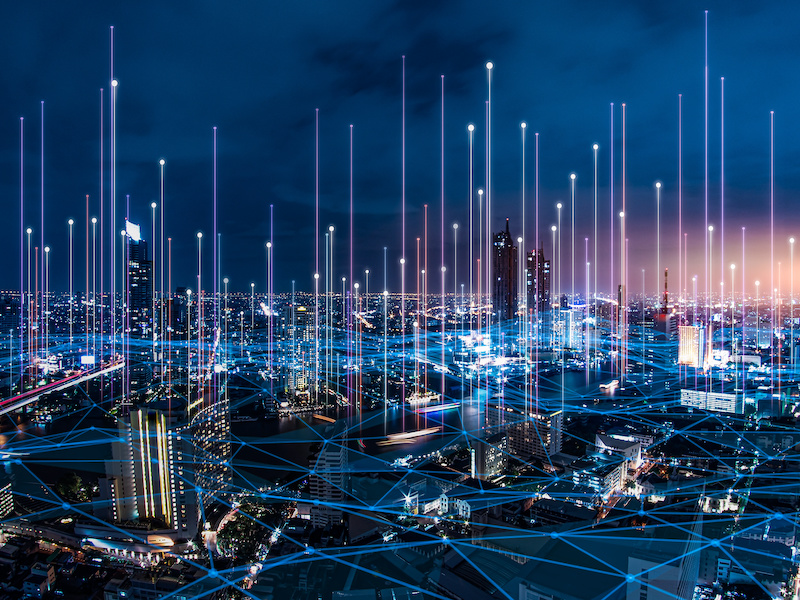5-minute read
Quick summary: Where DER aggregators have come from, where they stand today, and the AI-driven tools and technologies that can help them adapt to their role in shaping the grid of the future
The marvel of engineering known as the U.S. national grid is evolving at a rapid pace. The monolithic one-way system of power generation, transmission, and distribution that has served us for decades is giving way to a multidirectional, distributed structure where providers, consumers, and prosumers interact on a minute-by-minute basis. As penetration of distributed energy resources (DERs) continues to increase, DER aggregators are playing a more significant role in ensuring a safe, reliable flow of electricity. In this article, we’ll look at where DER aggregators have come from, where they stand today, and the AI-driven tools and technologies that can help them adapt to their role in shaping the grid of the future.
What is a DER aggregator?
Most DERs connected to the grid are small and medium-sized power resources—think individual homes with solar panels or community wind farms. Aggregators are independent businesses that “bundle” individual DERs into a single entity (sometimes called a virtual power plant, or VPP) capable of engaging in electricity markets.
The Federal Energy Regulatory Commission (FERC) defines a DER aggregator as “an entity that aggregates one or more DER for purposes of participation in the capacity, energy, and ancillary service markets of the regional transmission operators and independent system operators.”
DER aggregators offer an array of benefits to grid operators, including
-
- Reducing the marginal cost of power to cover peak demand
- Enabling optimization of infrastructure investments
- Delivering ancillary services such as load shifting and balancing
Aggregators are independent businesses that “bundle” individual DERs into a single entity (sometimes called a virtual power plant, or VPP) capable of engaging in electricity markets.
A tried-and-true concept
The idea behind DER aggregation is nothing new. Its origins can be traced back to the 1980s, when utilities began to outsource management of their demand response programs to third-party companies, which came to be known as demand response providers (DRPs). These DRPs worked with large consumers of electricity (typically commercial and industrial customers) to reduce their usage during peak demand hours.
In response to increasing penetration of DERs such as rooftop solar panels, DRPs began working with these smaller resources in providing demand response services. As the distributed energy market continued to grow, DRPs evolved into the DER aggregators we know today, providing a range of services to both grid operators and resource owners.
Article continues below.
WEBINAR
The DERMS journey: Keys to successful implementation
WHITE PAPER
Planning for net-zero utilities: Integrating renewables and DERs
How FERC is changing the game
In September 2020, FERC issued Order No. 2222, requiring regional transmission organizations (RTOs) and independent system operators (ISOs) to develop plans for giving DERs access to wholesale energy markets. The order also establishes DER aggregators as a new category of market participant.
Currently, only one ISO under FERC jurisdiction, California’s CAISO, has received full approval for its Order 2222 compliance plan. Others—including MISO (Midcontinent), NYISO (New York), PJM (Pennsylvania, New Jersey, and Maryland), ISO-NE (New England), and SPP (Southwest)—have submitted plans that either have been partially accepted or are currently under review.
As Order 2222 advances towards full implementation, DER aggregators will play a significantly larger role in grid operations as they represent their customers in wholesale markets. Aggregators will also be required to ensure their customers abide by market rules and regulations regarding metering, telemetry, data collection, communication, and physical interconnection.
How AI can help DER aggregators prepare for their new role
If DER aggregators are to succeed in their new role as participants in wholesale markets, improvements in their operational efficiency will be essential. Fortunately, AI-driven technology provides the tools aggregators need to “level up” and meet the demands of their evolving responsibilities, particularly in the following use cases.
Forecasting customers’ generation capacity
Because most DERs involve renewable energy sources such as solar and wind power, their generation capacity can be difficult to predict. Solar energy can only be generated during daytime hours, and even then, a passing cloud can significantly affect output. Wind conditions can be equally variable, and severe weather conditions can even require wind farms to shut down for safety purposes.
AI models can help aggregators address these complexities by incorporating large amounts of real-time data, including current weather reports and forecasts as well as historical patterns, in forecasting DER output. The addition of machine learning enables these models to self-educate for continuous improvement, analyzing predictions versus results over time to generate ever more accurate results.
Collecting real-time customer data
A single DER aggregator can have hundreds of thousands of customers, and successfully representing these resources in wholesale markets requires a continuous flow of data.
Artificial intelligence enables data platforms to simultaneously gather and analyze data from thousands of sources at a speed far greater than humans. Aggregators can leverage AI models to collect the real-time customer information they need to make timely, data-driven decisions in selling their aggregated power on the open market.
Deriving insights from analytics regarding production, price, and settlement calculations
DER aggregators can leverage machine learning or deep learning to predict short- and long-term production from their aggregated resources. These predictions, coupled with other functions such as demand forecasting, managing risk of price volatility, and dispatch optimization, can enable aggregators to reach high levels of accuracy in their price and settlement calculations.
Meet the new power players
As FERC-regulated RTOs and ISOs progress towards implementation of Order No. 2222—and other operators such as ERCOT consider their own comparable measures—DER aggregators are being challenged to operate leaner, faster, and smarter. By tapping into the power of artificial intelligence, machine learning, and deep learning, aggregators can make the most of their resources as they lead their customers into the world of wholesale energy trading.

Powering a sustainable tomorrow
- Smart automation
- DERMS implementation
- Analytics & predictive insights
- Cloud optimization
Like what you see?

Managing Director of Grid Operations Alex Lago has over 30 years of experience in power system operations, wholesale power market operations, SCADA/EMS/GMS/DMS/OMS systems, and system/application design and implementation. He is passionate about advising companies on large-scale transformational projects and implementation of complex real-time operation systems.

